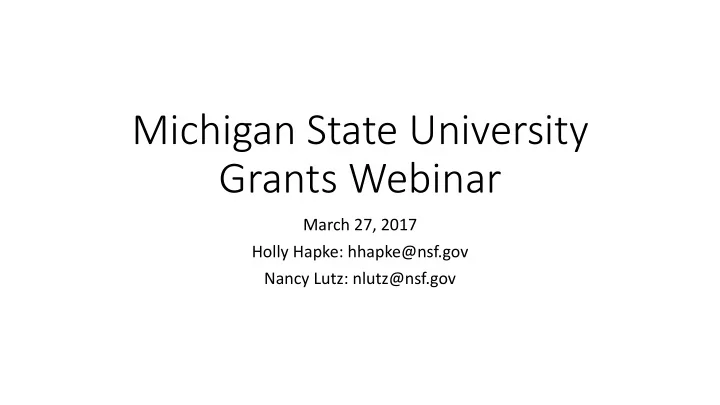

Michigan State University Grants Webinar March 27, 2017 Holly Hapke: hhapke@nsf.gov Nancy Lutz: nlutz@nsf.gov
Know Your Target • Different funding agencies have different priorities and interests and fund different kinds of projects. • Purposefully target appropriate funding agencies and do your proposal preparation homework • Seek to understand the mission and funding priorities of the agency or organization that may support your work and speak to these priorities and interests in your proposal.
NSF Mission: “ To pr promote the the pro progress of of sc scien ience; to ad advance the the na nati tional l hea health, pr prosperi rity an and d welfare; to secure the national defense…” NSF is an institution with real people who welcome inquiries and communication .
NSF funds Basic Science Research . Basic science research results in general knowledge that provides the means to answer important practical problems Basic scientific research is grounded in a theoretical framework. It uses scientifically sound approaches to investigate research questions. Its results contribute to enhancement of broader 4 theoretical knowledge.
NSF’s Merit Review Criteria • Intellectual Merit: The potential to advance knowledge. • To what extent do the proposed activities explore creative, original, or potentially transformative concepts? • Is the plan for carrying out the proposed activities well-reasoned, well-organized, and based on a sound scientific rationale ? • Broader Impacts : The potential to benefit society and contribute to the achievement of specific, desired societal outcomes.
Broader Impacts - Examples • Improved STEM education and/or educator development • Development of a diverse scientific workforce • Enhanced infrastructure for research & education • Increased public scientific literacy and/or public engagement with science and technology • Knowledge, products, and other contributions of direct value to society • Enhanced international scientific collaborations • Contributions to public policy; national security; improved U.S. economic competiveness
The NSF is Organized into Seven Directorates National Science Board Director Deputy Director Staff Offices Inspector General Biological Computer & Engineering Geosciences Mathematics Sciences Information & Physical Sciences Science & Engineering Budget, Finance & Award Social, Behavioral Education Information Management & Human Resource & Economic Resources Management Sciences
Directorates Are Divided into Divisions; Divisions Are Divided into Programs or Sections Social Behavioral and Economic Sciences National Center for Behavioral & Social & Economic SBE Multidisciplinary Science & Cognitive Sciences Sciences Activities Engineering Statistics Economics Geography & Spatial Sciences Decision, Risk & Management Sciences Anthropology Programs Methodology, Measurement & Statistics Sociology Psychology & Linguistics Programs Political Science Law & Social Science Science, Technology & Society => Consult with cognizant Program Officers for program specific information and READ program descriptions and solicitations carefully!
Must Do: Know Your Target • What are their goals? • What is the process for application, review, and decision? • What are they funding right now? “Successful proposals contribute to the mission, are written to be compelling to the unique audience, and are in a format that allows them to be reviewed appropriately.” – Rachel Croson
Example: NSF Awards Database
Advanced Search Webform
How To Approach An NSF Program Director Do: Email. • Copy all pds working on the program (or specific contact listed for your research field). • Include one-two page description of your idea/project: Question, Theory, Methods, Major Cites. • Include specific questions. • Ask if this is ‘suitable for the program’ or if we know of any other special opportunities. • Offer to follow up via phone. Do: Ask if we’re attending a professional meeting. Do: Introduce yourself at conferences, etc.
Reasons for Declinations • “Trust - me” proposal • No theory, no methods, or poor match between theory and methods • Not feasible • Expertise gaps • Too ambitious • Incremental contribution • Bad luck
Broadening Participation • NSF is committed to expanding the diversity of the US scientific workforce. • Programs that support INSTITUTIONAL efforts to broaden participation: • INCLUDES • ADVANCE • HBCU-UP, HBCU-RISE, CREST, HBCU DCL • Louis Stokes Alliances for Minority Participation (LSAMP) • Science of Broadening Participation DCL • Tribal Colleges & Universities Program (TCUP)
NSF INCLUDES: Inclusion across the Nation of Learners of Under-represented Discoverers in Engineering and Science (NSF 17-522) • Seeks to diversify the composition of the science and engineering workforce to better reflect the diversity of US society through the creation of a network of alliances and backbone infrastructure to achieve and sustain the shared goal of broadening participation nationwide. • Funds Collaborations, not isolated interventions of individual organizations, in effort to scale-up efforts.
For Individual Researchers: • Funded by submitting a proposal to a program. • Every program at NSF is committed to broadening participation and increasing diversity in the scientific workforce. • Within portfolios, program officers are mindful of expanding opportunity. • Investigators from Under Represented Minority communities who submit high quality proposals do get funding from NSF.
HBCU Dear Colleague Letter (DCL) • NSF 17-027 (Issued November 4, 2016) • Builds on success of DCL 16-080 to strengthen research capacity at HBCUs • Invites researchers at HBCUs to submit research proposals • Supported by outreach efforts by multiple Directorates • SBE Directorate – a pool of program officers available to conduct information sessions for prospective investigators • Points of Contact for SBE: • Holly Hapke – hhapke@nsf.gov • Kwabena Gyimah-Brempong – kgyimahb@nsf.gov
SBE: Science of Broadening Participation • “Integrative, interdisciplinary field of inquiry based upon the theoretical perspectives as well as the methods and analytic tools of the social sciences and education research to advance understanding of practical, effective and successful efforts aimed at broadening participation in STEM. ” • SBP Research Addresses: • Issues of access, inclusion and retention by documenting the inequitable distribution of educational and economic opportunities. • Information at all levels of analysis of behavior including the individual, group and societal. • Collaboration between SBE scientists and those in the natural and physical sciences engaged BP efforts. • What works and what doesn’t work to reduce disparity in STEM participation!
Recommend
More recommend